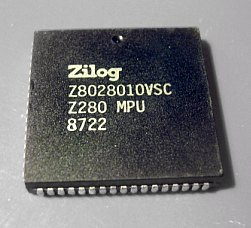Zilog Z280: Difference between revisions
Guy Harris (talk | contribs) There's a page for instruction pipelining; just use that. |
Mate Juhasz (talk | contribs) Added Citation needed tag for Illegal instruction trap |
||
| Line 16: | Line 16: | ||
* User I/O [[Trap (computing)|trap]] |
* User I/O [[Trap (computing)|trap]] |
||
* [[Supervisor mode]] ([[Privilege (computing)|privileged]] instructions) |
* [[Supervisor mode]] ([[Privilege (computing)|privileged]] instructions) |
||
* [[Illegal instruction]] trap |
* [[Illegal instruction]] trap{{Citation needed|reason=The Z280 manuals available online don't mention this trap|date=August 2021}} |
||
* [[Coprocessor]] emulation [[Trap (computing)|trap]] |
* [[Coprocessor]] emulation [[Trap (computing)|trap]] |
||
* [[Burst mode (computing)|Burst mode memory access]] |
* [[Burst mode (computing)|Burst mode memory access]] |
||
Revision as of 06:49, 21 August 2021


The Zilog Z280 is a 16-bit microprocessor, an enhancement of the Zilog Z80 architecture, introduced in July 1987. It is basically the Z800, renamed, with slight improvements such as being fabricated in CMOS.[1] It was a commercial failure. Zilog added a memory management unit (MMU) to expand the addressing range to 16 MB, features for multitasking and multiprocessor and coprocessor configurations, and 256 bytes of on-chip static RAM, configurable as either a cache for instructions and/or data, or as part of the ordinary address space. It has a huge number of new instructions and addressing modes giving a total of over 2000 combinations. It is capable of efficiently handling 32-bit data operations including hardware multiply, divide, and sign extension. It offers Supervisor and User operating modes, and optionally separate address spaces for instructions and data in both modes (four total possible address spaces). Its internal clock signal can be configured to run at 1, 2 or 4 times the external clock's speed (e.g. a 12MHz CPU with a 3 MHz bus). Unlike the Z80 the Z280 uses a multiplexed arrangement for its address and data busses. More successful extensions of the Z80-architecture include the Hitachi HD64180 in 1986 and Zilog eZ80 in 2001, among others. See further Zilog Z800.
The Z280 had many advanced features for its time, most of them never seen again on a Zilog processor:
- On-chip instruction and/or data cache, or on-chip RAM
- Instruction pipelining
- High performance 16-bit Z-BUS interface or 8-bit Z80-compatible bus interface
- Built-in MMU with memory protection
- Ability to determine which register set is in context with instructions JAF and JAR
- Four on-chip 16-bit counter/timers
- Four on-chip DMA channels
- On-chip full duplex UART
- User I/O trap
- Supervisor mode (privileged instructions)
- Illegal instruction trap[citation needed]
- Coprocessor emulation trap
- Burst mode memory access
- Multiprocessor support, with many bus configuration modes
- Support for multiple external coprocessors through an accelerated communication interface
- Multiple I/O pages, which also allows for internal I/O devices without restricting the address range of the I/O ports like on eZ80, or conflicting with existing motherboard devices, like the Z180.
- Stack overflow warning
Notes
References
- ^ EDN November 27, 1986 p133
- Z280 MPU Microprocessor Unit Preliminary Technical Manual (PDF). San Jose, California: Zilog. 1989. Retrieved 2009-07-15. (Note: 20MB pdf file)
- Z80 Family Data Book. San Jose, California: Zilog. January 1989.
- Reh, Tilmann (1991-09-16). "The CPU280 and Z280". TCJ. Retrieved 2009-07-15.
Further reading
- Harston, J.G. (1998-04-15). "Full Z280 Opcode List". Retrieved 2009-07-15.
This article is based on material taken from the Free On-line Dictionary of Computing prior to 1 November 2008 and incorporated under the "relicensing" terms of the GFDL, version 1.3 or later.
